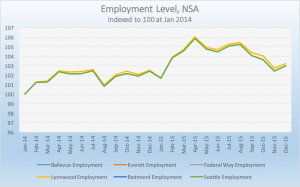@TBPInvictus
The recent piece by AEI “scholar” Mark Perry on Seattle’s minimum wage – see here – has continued to make its way throughout the right wing echo chamber. It was picked up at the Competitive Enterprise Institute (of which I’ve never heard), then on over to the Foundation for Economic Freedom (never heard of them, either) and, finally, to the granddaddy of them all, ZeroHedge.
Of course, Perry’s piece was thoroughly and thoughtfully debunked by Michael Hiltzik at the LA Times, and I followed up on Hiltzik’s work here.
The issue really centered around Hiltzik’s discovery that the employment levels in least five other cities around the Seattle area were moving in lock-step with Seattle’s. After all, Seattle’s minimum wage – if it were having a deleterious effect – should have that city standing apart from its neighbors. But that’s not what the data show, as I clearly demonstrated:
There are six – yes, six – cities represented in that chart, and their employment levels, indexed to 100 at January 2014, have moved in near-perfect sync with one another. How is Seattle faring worse than any of its neighbors – Bellevue, Everett, Federal Way, Lynnwood, or Redmond? Answer: It’s not.
Neither Perry nor any of those subsequently citing his work noticed nor, I’m sure, care. It matters not. Only the narrative, the ideology, matters.
Yet there is a reason, and I contacted the Bureau of Labor Statistics to get it. Here is what I was told (my emphasis):
What you observe is a consequence of our methodology. City employment is disaggregated from the county level based on shares from the Census Bureau’s American Community Survey (ACS) that are indexed to post-censal population estimates to account for differential growth. Cities disaggregated from the same county can vary independently in terms of their LAUS employment growth only insofar as their population trends differ as determined by the Census Bureau. Even this overstates the potential for independent variation over the period of specific interest to you, because the disaggregation ratios currently in use reflect employment shares from the 2009-13 ACS 5-year dataset indexed to vintage-2013 post-censal population estimates. This is to say that the disaggregation ratios underlying each city’s employment estimates from January 2013 through December 2015 are the same (e.g., Seattle city received 35.4 percent of the King County employment for each of the latest 36 months). City growth thus has moved in lock-step with county growth over this period, which means that cities within the same county have moved in lock-step with each other.
County employment estimation is somewhat more sophisticated. However, given that the two counties of interest to you (King and Snohomish) are the exhaustive components of the model-based Seattle-Bellevue-Everett, WA Metropolitan Division, the lack of variation in LAUS employment growth between them (and, thus, between the cities within them) is not surprising. The vast majority of LAUS employment (the wage and salary worker component) is disaggregated from the metropolitan division to the counties based on shares that, similar to the city disaggregation ratios described above, were fixed over the January 2013 through December 2015 period. There is some independent variation potentially coming from the other components of LAUS employment estimation at the county level, but these generally account for less than 10 percent of employed persons.
In short, LAUS data are not going to be particularly useful for comparing recent household employment growth across such neighboring cities, given the sources that we have to work with.
The LAUS program is a hierarchy of non-survey methodologies designed to produce topside estimates for subnational areas that are consistent with the CPS concepts of employment and unemployment. We model data for states, based primarily on their CPS subsamples. For counties, we used a building-block approach to estimate shares of statewide employment and unemployment. For cities, a disaggregation technique is used. Moving down this hierarchy of methodologies, the availability of relevant estimation inputs diminishes, and the role of assumptions correspondingly increases.
In short, the LAUS data on which Perry relied are not particularly useful, at least in the very short run, for the purpose on which he relied on them. Perry and his minions might have researched this, as Hiltzik did. But they didn’t. They could, having been told that their work is garbage, corrected or retracted it. But they didn’t.
Again, for the umpteenth time, the Seattle minimum wage experiment is going to play out over the course of years, not quarters or months. It should be left at that, but some find the temptation to torture data just too compelling.


